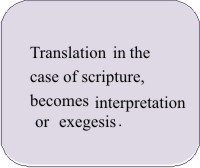| |
The Torah
Let us first take into consideration the oldest of the Semitic religions, which is Judaism. The Torah is the foundational religious text for the Jews, and is also called Pentateuch or the Five Books of Moses. It is part of the Christian Old Testament, and is acknowledged by Muslims as well, as a holy book. The language of the Torah is Hebrew, which is not understood by many Jews scattered across the world. Contrary to the suspicion that other religions exhibit towards translation, the Jews believed that the Torah contains divine truths meant to be understood by humans. So the Torah had to be translated and its teachings propagated for the benefit of those who do not understand Hebrew. Michael Alpert observes that the first reference to translation can be found in the Bible itself. It is mentioned that the Jews who returned from exile in Babylon could no longer understand Hebrew and so they read the Torah: “they read from the book of the law of God clearly, made its sense plain and gave instruction in what was read” (Torah translation, Routledge Encyclopedia, 269). Alpert interprets this as translation.
According to Alpert, the first translation of the Torah is the Septuagint, a translation done in Egypt in the third century BC for the benefit of Jews who did not know Hebrew. This translati on was considered unsatisfactory by many Jews and there came along other translations after this. There were translations into Aramaic which were called targum (targumin means translation in Hebrew). The Torah was read in the synagogue and the Aramaic interpretation given orally by the meturgeman or the interpreter/translator. Alpert points out that it is difficult to separate translation from exegesis in the case of the Torah or the Bible (270). This also applies to the earliest Arabic translation of the Torah by Saadia in the 10th century. Saadia who was a Hebrew scholar himself, explained Hebrew grammar and syntax using parallels from Arabic. His translation is still used by Yemenite Jews. on was considered unsatisfactory by many Jews and there came along other translations after this. There were translations into Aramaic which were called targum (targumin means translation in Hebrew). The Torah was read in the synagogue and the Aramaic interpretation given orally by the meturgeman or the interpreter/translator. Alpert points out that it is difficult to separate translation from exegesis in the case of the Torah or the Bible (270). This also applies to the earliest Arabic translation of the Torah by Saadia in the 10th century. Saadia who was a Hebrew scholar himself, explained Hebrew grammar and syntax using parallels from Arabic. His translation is still used by Yemenite Jews.
|